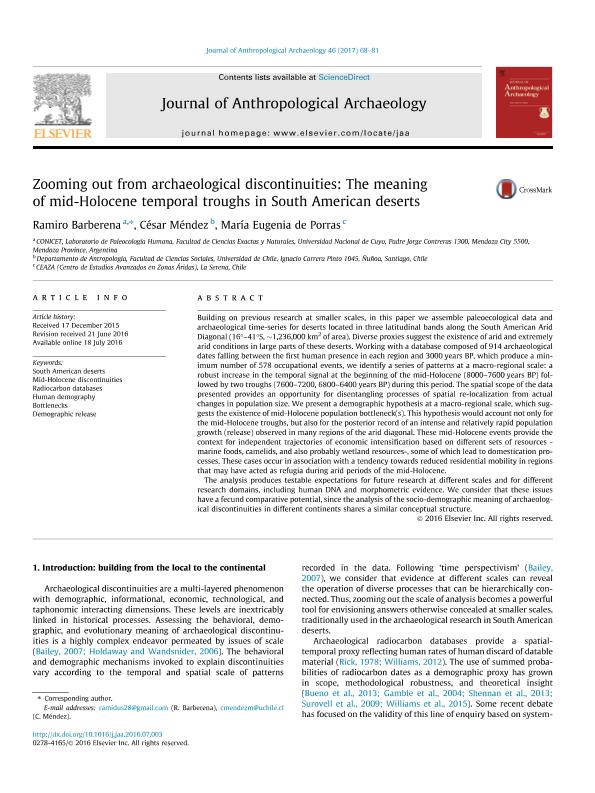Mostrar el registro sencillo del ítem
dc.contributor.author
Barberena, Ramiro

dc.contributor.author
Méndez, César
dc.contributor.author
de Porras, Maria Eugenia

dc.date.available
2018-12-21T17:42:05Z
dc.date.issued
2017-06
dc.identifier.citation
Barberena, Ramiro; Méndez, César; de Porras, Maria Eugenia; Zooming out from archaeological discontinuities: The meaning of mid-Holocene temporal troughs in South American deserts; Academic Press Inc.; Journal of Anthropological Archaeology; 46; 6-2017; 68-81
dc.identifier.issn
1090-2686
dc.identifier.uri
http://hdl.handle.net/11336/66918
dc.description.abstract
Building on previous research at smaller scales, in this paper we assemble paleoecological data and archaeological time-series for deserts located in three latitudinal bands along the South American Arid Diagonal (16°–41°S, ∼1,236,000 km2 of area). Diverse proxies suggest the existence of arid and extremely arid conditions in large parts of these deserts. Working with a database composed of 914 archaeological dates falling between the first human presence in each region and 3000 years BP, which produce a minimum number of 578 occupational events, we identify a series of patterns at a macro-regional scale: a robust increase in the temporal signal at the beginning of the mid-Holocene (8000–7600 years BP) followed by two troughs (7600–7200, 6800–6400 years BP) during this period. The spatial scope of the data presented provides an opportunity for disentangling processes of spatial re-localization from actual changes in population size. We present a demographic hypothesis at a macro-regional scale, which suggests the existence of mid-Holocene population bottleneck(s). This hypothesis would account not only for the mid-Holocene troughs, but also for the posterior record of an intense and relatively rapid population growth (release) observed in many regions of the arid diagonal. These mid-Holocene events provide the context for independent trajectories of economic intensification based on different sets of resources -marine foods, camelids, and also probably wetland resources-, some of which lead to domestication processes. These cases occur in association with a tendency towards reduced residential mobility in regions that may have acted as refugia during arid periods of the mid-Holocene. The analysis produces testable expectations for future research at different scales and for different research domains, including human DNA and morphometric evidence. We consider that these issues have a fecund comparative potential, since the analysis of the socio-demographic meaning of archaeological discontinuities in different continents shares a similar conceptual structure.
dc.format
application/pdf
dc.language.iso
eng
dc.publisher
Academic Press Inc.
dc.rights
info:eu-repo/semantics/openAccess
dc.rights.uri
https://creativecommons.org/licenses/by-nc-sa/2.5/ar/
dc.subject
Bottlenecks
dc.subject
Demographic Release
dc.subject
Human Demography
dc.subject
Mid-Holocene Discontinuities
dc.subject
Radiocarbon Databases
dc.subject
South American Deserts
dc.subject.classification
Historia

dc.subject.classification
Historia y Arqueología

dc.subject.classification
HUMANIDADES

dc.title
Zooming out from archaeological discontinuities: The meaning of mid-Holocene temporal troughs in South American deserts
dc.type
info:eu-repo/semantics/article
dc.type
info:ar-repo/semantics/artículo
dc.type
info:eu-repo/semantics/publishedVersion
dc.date.updated
2018-12-19T14:40:37Z
dc.journal.volume
46
dc.journal.pagination
68-81
dc.journal.pais
Estados Unidos

dc.journal.ciudad
Nueva York
dc.description.fil
Fil: Barberena, Ramiro. Consejo Nacional de Investigaciones Científicas y Técnicas; Argentina. Universidad Nacional de Cuyo. Facultad de Ciencias Exactas y Naturales; Argentina
dc.description.fil
Fil: Méndez, César. Universidad de Chile; Chile
dc.description.fil
Fil: de Porras, Maria Eugenia. Consejo Nacional de Investigaciones Científicas y Técnicas; Argentina. Comisión Nacional de Investigación Científica y Tecnológica. Centro de Investigación Regional. Centro de Estudios en Zonas Áridas; Chile
dc.journal.title
Journal of Anthropological Archaeology
dc.relation.alternativeid
info:eu-repo/semantics/altIdentifier/url/https://www.sciencedirect.com/science/article/pii/S0278416516300678
dc.relation.alternativeid
info:eu-repo/semantics/altIdentifier/doi/https://doi.org/10.1016/j.jaa.2016.07.003
Archivos asociados
